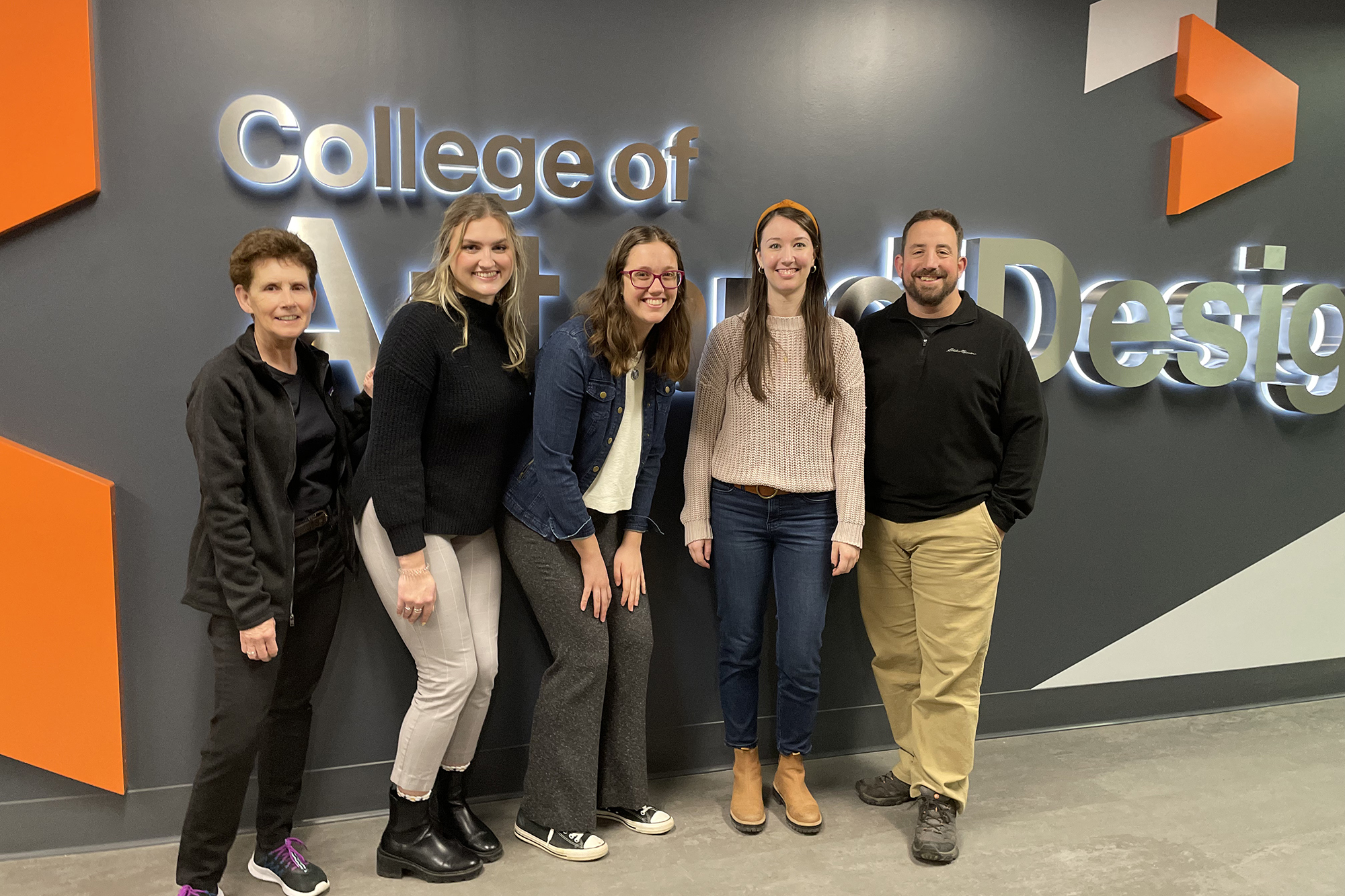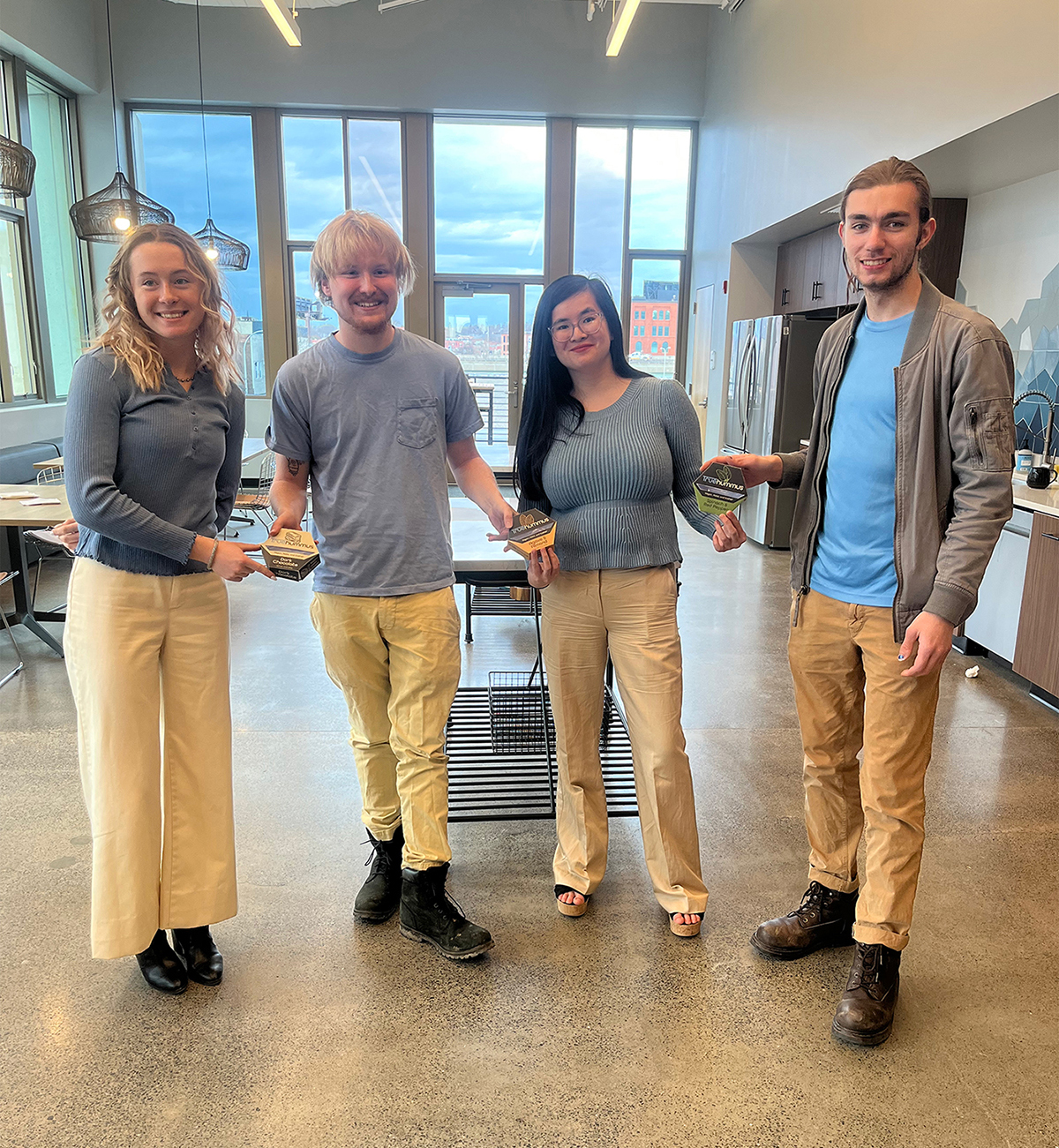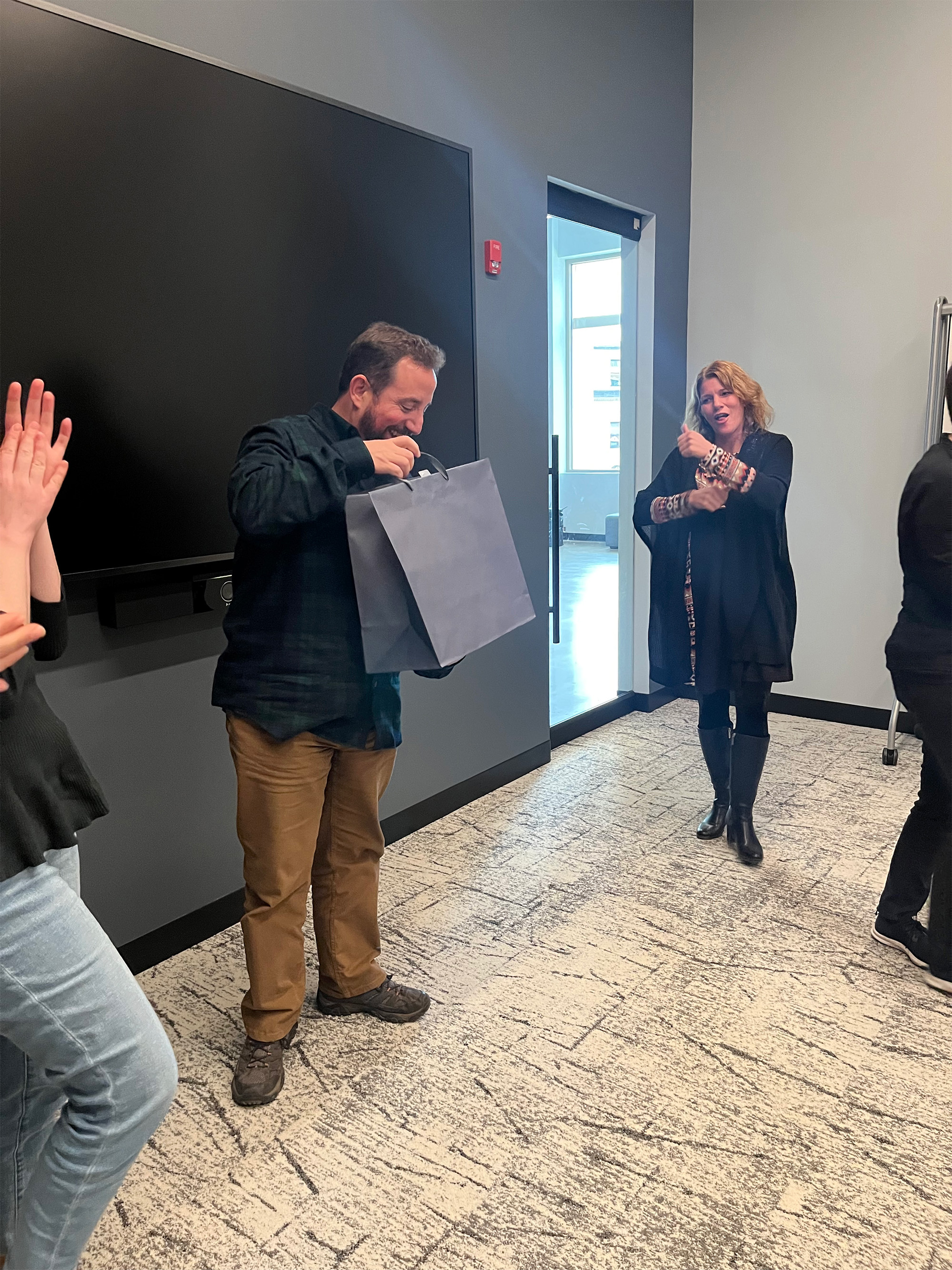Course collaboration opens professional doors for design students
ChaseDesign representatives and Professor Lorrie Frear during an RIT visit in early 2023 as part of Frear's Packaging Systems Projects course, which allows students to complete a project sponsored by the design firm. The partnership often has added RIT flavor due to Chase's propensity to hire graphic design alumni. From left: Frear, along with project leaders and Chase employees Rachel Pachilis ’21, Maggie Blaisdell '22, Leah Kotas '17 and Jon Cammarata.
Maggie Blaisdell ’22 (graphic design) is living proof of the payoff to advice Professor Lorrie Frear delivers students in her Packaging Systems Projects course.
Since 2016, graphic design and industrial design students have worked in teams to complete a project sponsored by ChaseDesign, a design firm with four locations including in nearby Syracuse, N.Y. Blaisdell remembers Frear expounding that interactions with the company should be treated like job interviews.
Blaisdell took that counsel to heart.
Following a positive experience collaborating with Chase, Blaisdell was hired to work at the firm immediately after graduating. During a portfolio review with Chase at Creative Industry Day her senior year, Blaisdell said the company cited its familiarity with both her work and soft skills as standout traits as a job candidate.
“That was my priority class — the one I put most of my time and effort into because it felt like a catalyst for things,” said Blaisdell, a graphic designer for Chase. “I found a lot of value in it.”
Over the years, the Packaging Systems class has introduced students to Chase’s real-life design problems they are tasked with developing solutions for. Last spring, students proposed concepts for new, artisanal hummus products with sustainable packaging that redesigns how hummus is delivered in stores.
The multi-week project traditionally consists of a kickoff event, mid-project check-in at Chase’s Syracuse location and final presentations judged by Chase designers.
“The commitment by everyone at Chase in terms of leading projects, providing thoughtful feedback and sharing their time is invaluable to our students and program,” Frear said. “This course is an archetype of our program, and is a rewarding experience for everyone.”
RIT graphic designers hold present their new hummus packaging prototypes at ChaseDesign's Syracuse offices during the spring 2023 semester. From left: Skylar Pitts, Lucas O'Connor, Olivia Germano and Sam Klein.
Jon Cammarata, a senior design director at Chase, has steered the company’s last few collaborations with RIT.
“When we see the students using our ChaseDesign process for designing and attacking a problem, and understanding why you do all that, you can tell they see the value in it,” Cammarata said. “That’s what’s so rewarding at the end, to see how they grow in just four short weeks. It’s wonderful.”
To maximize the students’ experience, Cammarata and his team provide thorough feedback, but intentionally refrain from offering a clear solution. The goal is to empower RIT designers to create something informed, yet authentically them.
“That’s our role as the Chase team — to guide the students versus run the project,” Cammarata said. “We want them to own it so at the end they can be proud of what they invented, and have something they can put in their portfolio with pride.
When Blaisdell was hired, she continued a lineage of RIT graphic design alumni to work at Chase. She is among a contingent of School of Design graduates currently with the company.
Fellow graphic design alumni and Chase employees Leah Kotas ’17 (senior designer) and Rachel Pachilis ’21 (graphic designer) joined Blaisdell and Cammarata to lead the prompt for the spring 2023 Packaging Systems class.
Cammarata likened check-in visits from Frear’s class to a reunion for Chase employees delighted to see their former professor.
Cammarata accepts the swag-infused invitation to be an unofficial honorary RIT alumnus.
“When (Frear) comes over there are like 10 different alumni who come and hug her,” said Cammarata, who was unofficially made an honorary alumnus last spring by Frear with an offer of RIT swag.
With Blaisdell being on both sides of the class, as a student and now an industry partner, she gained an unabridged perspective of the course’s significance.
“By the end of my time working with Chase as an RIT student I had a better understanding of how to present my work,” Blaisdell said. “The work itself is important. But it’s how you design your deck, how you talk about the work in context that sells the work. I fully understand the value of it now that I’m the recipient of the presentation, not the giver of it.”
As an added benefit to the Packaging Systems course, it places students squarely on Chase’s recruiting radar.
To Cammarata, the networking is a bonus to students receiving a chance to simulate a professional design project.
“Our team has been exposed to these students and learned their work ethic, their quality of design, the way they can interact with people and present their work,” Cammarata said. “These are things you can’t get from just looking at their portfolio on a website or reviewing a resume.
“I tell the students you’re going to have a whole leg up, if not a whole body up, on your peers.”
Cammarata’s involvement in the class has given him an insightful look at the RIT graphic design program’s ethos. The course has helped bring more awareness to the credibility of RIT students — which has manifested in the company’s recruiting pipeline.
“RIT is one of the best graphic design programs we’ve ever seen, in how well the students are prepared when they graduate,” Cammarata said. “They have a well-rounded education in graphic design and typography. RIT has something different, an intangible to their students. You can see the passion is there. It reassures us we’re putting our efforts into a more-than-worthy program.”











